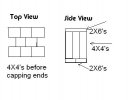- Joined
- Jan 1, 2006
- Messages
- 55
Okay all, I 've done a search but couldn't find exactly what I needed. I have a good 110# anvil that was a gift. Great rebound , but no idea who makes it .My brother-in-law got it for me from hammer source I think. At any rate I am not sure what would be the best, most inexpensive and quasi-portable way to mount it. Any Ideas? I had thought about 11"x5" rectangles of MDF screwed or bolted one to another, and since my anvil doesn't have holes in the feet I was thinking about 1/4' wire cable securing the anvil to the the base.Then I would router an x shaped groove in the base so the cable could go underneath the stand. I thought about cable tensioners to tighten the whole thing down. Does this sound workable? Any other Ideas?


